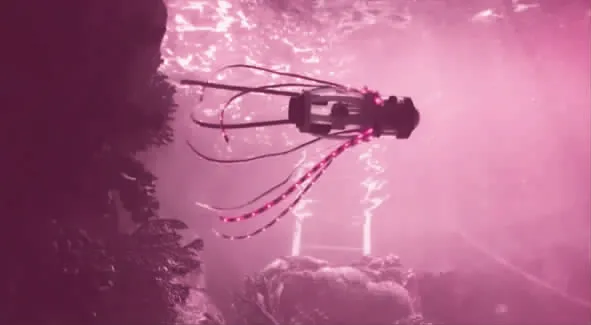河北 胡金莹
为了能够在不破坏珊瑚等海洋生物的情况下探索水下环境,科学家们从鱿鱼的喷射推进机制中吸取灵感,发明了一款功能强大的机器人。

题材机器人 说明文体裁 文章词数 建议用时约3598分钟
难词探意
1. self-propelling/self prə΄pelɪŋ/adj.自我推进的
2. squid /skwɪd/ n. 鱿鱼
3. rib /rɪb/ n. 肋骨
4. contract /΄kɒntrækt/ v.(使)收缩;缩小
5. feasibility /ˌfiːzə΄bɪləti/ n. 可行性
Soft robots, which can move around the ocean without harming sea life, are ideal for underwater exploration. However, they are rarely used because they are extremely slow and have a hard time traveling through the water. But that may change soon thanks to a new, self-propelling soft robot.
For their design, the researchers drew inspiration from one of nature's fastest swimmers—squids. They can use their strong muscles to draw in water and promptly spread it out. By doing this, they are able to move forward at rapid speeds.
The recently-developed robot, which resembles a paper lantern, was primarily built using soft materials. Its flexible ribs are attached to a circular plate at both ends. An adjustable nozzle (喷嘴)fitted on one side helps draw in and release water each time the robot contracts. The resulting jets of water enable it to move forward, similar to a squid. The other plate holds a waterproof space that can house a camera or a sensor, to record data. The robot also has its own power source, allowing it to float autonomously for long periods of time.

“Basically, we recreated all the key features that squids use for high-speed swimming. This is the first robot that can produce jet pulses for rapid movement like the squid and can achieve these jet pulses by changing its body shape, which improves swimming efficiency,” said one of the designers.
While the squid robot has not been tested in open waters, it successfully weaved around coral and fish in a large aquarium. What's more, the robot had an impressive speed of 18 to 32 centimeters per second, or about half a mile per hour. Though it is nowhere close to real squids, which travel between 23 and 25 miles per hour, it is faster than most other soft robots.
After being able to make full use of the design of the robot so that it would swim in a tank in the lab, it was especially exciting to see that the robot was able to successfully swim in a large aquarium among coral and fish, showing its feasibility for real-world applications.
1. Why are soft robots chosen to explore the sea?
A. To avoid harming sea life. B. To ensure their flexibility.C. To protect human beings. D. To save the energy.
2. What does the underlined word “promptly” mean in paragraph 2?
A. Slowly. B. Rapidly. C. Properly. D. Effectively.
3. What does paragraph 3 mainly tell us about the squid robot?
A. Its appearance. B. Its advantage.
C. Its working process. D. Its influence.
4. What can we know about the squid robot?
A. It hasn't been used in open waters.
B. It can move no slower than real ones.
C. It is the first soft robot used in oceans.
D. It can produce energy while moving.
Sentence for writing
While the squid robot has not been tested in open waters, it successfully weaved around coral and fish in a large aquarium.
【信息提取】while引导让步状语从句,意为“尽管;虽然”。
【句式仿写】虽然在处理这个棘手问题的时候我们经历了很多困难,但是最终我们成功了。



